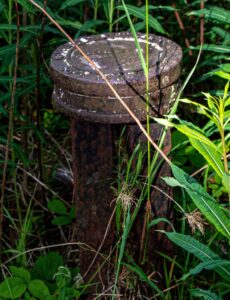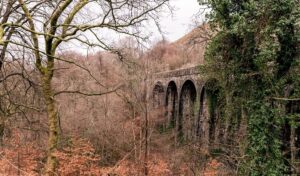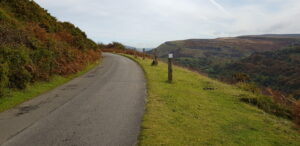Railroads and tram roads were developed to carry limestone from the quarries to the ironworks, and then to export iron and coal to the canals.
Due to considerable demand we have reprinted 'Powell's History of Tredegar' and are pleased to announce that it is now available to buy. Dismiss
Railroads and tram roads were developed to carry limestone from the quarries to the ironworks, and then to export iron and coal to the canals.
Opened in 1794
Beaufort to Gilwern Canal Wharf
The Clydach Railroad ran all the way down Clydach Gorge and was an edge rail system permitted by the 1793 Canal Act. It was first railroad to connect the upland coal and iron works with the Brecon & Abergavenny Canal at Gilwern. Completed by 1794, at least three years before the canal construction began, the tramroad was used to help finance the canal project by transporting iron to Glangrwyne Forge and supplying the Usk Valley coal and lime trade, and using lime from Black Rock Quarries and coal from the canal company’s Gelli Felen coal works. The latter was via a tramroad link from Pont Harri Isaac.
Reaching Brecon by 1800 the canal made this town an important coal-trading centre with tramroad links into Radnor and Herefordshire. Canal and feeder traffic increased greatly after 1812 when it was extended to Newport and the sea. At Gilwern the Clydach Railroad was provided with its own canal loading wharf, the original line to Glangrwyne passing under the waterway through an arched aqueduct.
The Clydach Railroad would transport heavy loads of Beaufort and Ebbw Vale cast iron and Black Rock limestone down the gorge carrying much Usk Valley timber and animal fodder for the return. (Darren Ddu – Black Rock- Limestone quarries were connected by way of a tramroad spur.) However heavy loading caused such edge-rail breakage it was soon converted into an L-shaped plateway.
Rails were cast at Merthyr’s Penydarren Iron Works and possibly Pen y Cae iron works, Ebbw Vale. Not many examples survive although one was used at the Drum and Monkey public house as a fire bar for many years, and another is fixed to a wall near Gilwern wharf.
The canal and its feeder tramroads – without which it could not have operated – would be killed commercially by steam railways. By 1864 trade had fallen almost to nothing and the Clydach Railroad was supplanted by the new Merthyr-Tredegar and Abergavenny Railway.
Eifion Lloyd Davies and Peter Morgan Jones
Follow the link below to see more detailed images of this railroad.
Opened in 1794
Sirhowy Ironworks to Beaufort Ironworks
The Rassa Railroad was, initially, a horse-drawn railroad in south Wales, running between Sirhowy Ironworks and Beaufort Ironworks. It was laid out by Thomas Dadford who was the engineer of the Monmouthshire Canal Co., which owned the line
It opened in 1794 as an edge railway of 3 ft 4 in gauge but after a few years was converted to a 4 ft 2 in gauge plate way. A tram engine was used on the route from 1829. At some point the owner of the Rhymney Ironworks also secured running rights over the Rassa line.
The railway ran for 2.5 miles, directly north from Sirhowy then east through the village of Rassau to Beaufort. At Trevil Machine (location of a weighing machine), where the line turned sharply to the east, a junction was made with the Trefil Rail Road from the limestone quarries at Trefil. A further junction with the Trefil line at Shop Row led to the Ebbw Vale Ironworks at Pont-y-Gof.
The recommended carrying weight was up to 45 hundredweight per set of wheels, but loadings of up to 3 tons of iron were noted. Other materials carried included coal and limestone.

Boundery marker at Rassa railroad, Rassau, Ebbw Vale. Photo courtesy of Andrew George
Follow the link below to see more detailed images of this railroad
Opened in 1805
Tredegar to Nine Mile Point
The Sirhowy Tramroad was a plateway built to convey the products of ironworks at Tredegar to Newport, South Wales. It opened in 1805 between Tredegar and Nine Mile Point, a location west of Risca, from where the Monmouthshire Canal Company operated a tramroad to Newport.
The Sirhowy Tramroad was at first operated by horse traction, but by 1860 the Sirhowy Railway was being constructed in order to modernise the tramroad. It followed a similar alignment but with several modifications, and opened in 1863. It ran between Tredegar and Nine Mile Point. A short extension northward to Nantybwch,linking to the Merthyr, Tredegar and Abergavenny Railway, was opened shortly afterwards. The Sirhowy Railway was acquired by the London and North Western Railway, for which it formed a useful route to access Newport Docks.
The main traffic on the line was minerals: at first iron ore and later coal but with the decline of the traditional mineral industries and the loss of local general traffic, the line closed in 1960.
Opened in 1815
Trefil Quarries to Talybont on Usk Canal Wharf
Initiated by Benjamin Hall and built in 1815, (of Big Ben fame) the Bryn Oer (Brinore) tramroad was a cross-country route constructed to extend the tramroad which connected Benjamin Hall’s ironworks in the Rhymney valley to the limestone quarries at Trefil. This extension enabled his finished iron and coal to be carried to the Brecknock and Abergavenny Canal at Talybont on Usk.
Initiated by Benjamin Hall and built in 1815, (of Big Ben fame) the Bryn Oer (Brinore) tramroad was a cross-country route constructed to extend the tramroad which connected Benjamin Hall’s ironworks in the Rhymney valley to the limestone quarries at Trefil. This extension enabled his finished iron and coal to be carried to the Brecknock and Abergavenny Canal at Talybont on Usk.
The route to Trefil was known as ‘Hall’s Trefil Tramroad’ and the route across the moors to Talybont on Usk was know as the ‘Bryn Oer / Brinore tramroad. Brinore is an Anglicisation of Bryn Oer (Cold Hill) .
The tramways were operational from 1815. Horse drawn trams carried limestone from Trefil quarries southwards to Hall’s ironworks in Rhymney where it was used for fluxing and then the trams returned northwards to the canal at Talybont on Usk with the finished iron, picking up coal mined from the Bryn Oer Colliery on the way Once the products reached the canal they were taken by barge to the lucrative markets in Brecon.
Opened in 1821
Nantyglo Ironworks to Govilon Canal Wharf
Construction started on Crawshay Bailey’s Govilon tramroad in 1819 and was completed 2 years later. It was built to transport iron from Nantyglo Ironworks down through Clydach Gorge directly to Govilon Wharf and then onto the Brecknock and Abergavenny canal. By the 1850s tramroads were quite outdated and it was converted to a railway, the ‘Merthyr, Tredegar and Abergavenny Railway’ (MTAR), which opened in 1862

Merthyr, Tredegar and Abergavenny railway viaduct.
BLOG – It was actually quite a short walk, I only had just over an hour spare in a trip to Abergavenny. I took the opportunity to have a look at the Wharf at Govilon and the first few hundred yards of Bailey’s Tramroad.
A second visit to Govilon – Bailey’s Tramroad and the Heads of the Valleys line – Part 2
Opened in 1830
Darren Cilau Quarries to Nantyglo Ironworks
Around 1829 Crawshay Bailey built this tramroad to transport limestone from Darren Cilau Quarries above Llangattock to his Nantyglo Ironworks. After acquiring an earlier tramroad going from Darren Cilau quarries down to the Abergavenny and Brecknock canal at Llangattock he used it as an export route for his iron too.

Bailey’s Llangattock Tramroad – Photo Carolyn Jones